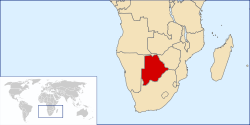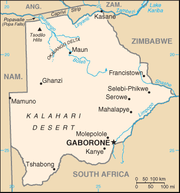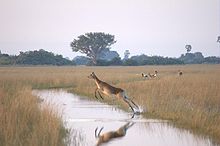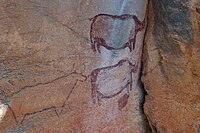Botswana
Republic of Botswana Lefatse la Botswana | |
|---|---|
| Motto: Pula Rain | |
| Anthem: Fatshe leno la rona This Land of Ours | |
 | |
| Capital and largest city | Gaborone |
| Official languages | English, Tswana (national) |
| Demonym(s) | Batswana |
| Government | Parliamentary republic |
| Ian Khama | |
| Independence from the United Kingdom | |
• Date | 30 September 1966 |
| Area | |
• Total | 600,370 km2 (231,800 sq mi) (46th) |
• Water (%) | 2.5 |
| Population | |
• 2006 estimate | 1,639,833 (147th) |
• Density | 3.0/km2 (7.8/sq mi) (231st) |
| GDP (PPP) | 2008 estimate |
• Total | $26.520 billion[1] |
• Per capita | $14,882[1] |
| GDP (nominal) | 2008 estimate |
• Total | $13.461 billion[1] |
• Per capita | $7,554[1] |
| Gini (2007/08) | 60.5 very high inequality |
| HDI (2007) | Error: Invalid HDI value (124th) |
| Currency | Pula (BWP) |
| Time zone | UTC+2 (CAT) |
• Summer (DST) | UTC+2 (not observed) |
| Drives on | Left |
| Calling code | +267 |
| ISO 3166 code | BW |
| Internet TLD | .bw |
The Republic of Botswana (Template:Lang-tn) is a landlocked country in Southern Africa. Citizens of Botswana are called "Batswana" (singular: Motswana), regardless of ethnicity. Formerly a British protectorate of Bechuanaland, Botswana adopted its new name after becoming independent within the Commonwealth on 30 September 1966. It is bordered by South Africa to the south and southeast, Namibia to the west and north, and Zimbabwe to the northeast. It meets Zambia at a single point.
Geographically the country is flat and up to 70% of Botswana is covered by the Kalahari Desert. Botswana was one of the most impoverished countries in Africa when it became independent in 1966. Today, it is home to a relatively stable political system and a rapidly developing market economy. Being closely tied with the economy of South Africa, the country's economy is one of the most successful in Africa and is dominated by the fast-growing service sector, world-renowned diamond industry, tourism, and manufacturing. Only about 30% of the population live below the international poverty line of US$1.25 a day[2] Botswana's development has outpaced Asian Tigers and the World Bank cites Botswana as one of the world's great development success stories.[3]
History
In the 19th century, hostilities broke out between the Tswana inhabitants of Botswana and Ndebele tribes who were migrating into the territory from the Kalahari Desert. Tensions also escalated with the Boer (European) settlers from the Transvaal. After appeals by the Batswana leaders Khama III, Bathoen and Sebele for assistance, the British Government put "Bechuanaland" under its protection on 31 March 1885. The northern territory remained under direct administration as the Bechuanaland Protectorate and is modern-day Botswana, while the southern territory became part of the Cape Colony and is now part of the northwest province of South Africa. The majority of Setswana-speaking people today live in South Africa.
When the Union of South Africa was formed in 1910 out of the main British colonies in the region, the Bechuanaland Protectorate, Basutoland (now Lesotho) and Swaziland (the "High Commission Territories") were not included, but provision was made for their later incorporation. However, a vague undertaking was given to consult their inhabitants, and although successive South African governments sought to have the territories transferred, Britain kept delaying; consequently, it never occurred. The election of the National Party government in 1948, which instituted apartheid, and South Africa's withdrawal from the Commonwealth in 1961, ended any prospect of incorporation of the territories into South Africa.
An expansion of British central authority and the evolution of tribal government resulted in the 1920 establishment of two advisory councils to represent both Africans and Europeans. Proclamations in 1934 regularized tribal rule and powers. A European-African advisory council was formed in 1951, and the 1961 constitution established a consultative legislative council.
In June 1964, Britain accepted proposals for a democratic self-government in Botswana. The seat of government was moved in 1965 from Mafikeng in South Africa, to the newly established Gaborone, which sits on its border. The 1965 constitution led to the first general elections and to independence on 30 September 1966. Seretse Khama, a leader in the independence movement and the legitimate claimant to the Ngwato chiefship, was elected as the first president, re-elected twice. The presidency passed to the sitting vice president, Quett Masire, who was elected in his own right in 1984 and re-elected in 1989 and 1994. Masire retired from office in 1998. The presidency passed to the sitting vice president, Festus Mogae, who was elected in his own right in 1999 and re-elected in 2004. The presidency passed in 2008 to Ian Khama (son of the first president), who resigned his position as leader of the Botswana Defence Force to take up this civilian role.
Geography and environment



At 231,788 mi² (600,370 km²), Botswana is the world's 45th-largest country (after Ukraine). It is comparable in size to Madagascar, and it is slightly smaller than the U.S. state of Texas. It is predominantly flat, tending toward gently rolling tableland. Botswana is dominated by the Kalahari Desert, which covers up to 70% of its land surface. The Okavango Delta, the world's largest inland delta, is in the northwest. The Makgadikgadi Pan, a large salt pan, lies in the north. The Limpopo River Basin, the major landform of all of southern Africa, lies partly in Botswana, in the southeast of the country.
Botswana has diverse areas of wildlife habitat. In addition to the delta and desert areas, there are grasslands and savannas, the latter where Blue Wildebeest, many antelopes, and other mammals and birds are found. Northern Botswana has one of the few remaining large populations of the endangered African Wild Dog.
Politics and government
The politics of Botswana take place in a framework of a representative democratic republic, whereby the President of Botswana is both head of state and head of government, and of a multi-party system. Executive power is exercised by the government. Legislative power is vested in both the government and the Parliament of Botswana. Since independence was declared, the party system has been dominated by the Botswana Democratic Party. The judiciary is independent of the executive and the legislature. According to Transparency International, Botswana is the least corrupt country in Africa and ranks similarly close to Portugal and South Korea.[4] The national anthem is Fatshe leno la rona.
Administrative divisions

Botswana is divided into 9 districts:
- Central District
- Ghanzi District
- Kgalagadi District
- Kgatleng District
- Kweneng District
- North-East District
- North-West District
- South-East District
- Southern District
Defence
At the time of independence Botswana had no armed forces. It was only after attacks from the Rhodesian and South African armies that the Botswana Defence Force (BDF) was formed in self-defence in 1977. The president is commander in chief and appoints a defence council. The BDF has approximately 12,000 members.
Following political changes in South Africa and the region, the BDF's missions have increasingly focused on combatting poaching, preparing for disasters, and foreign peacekeeping. The United States has been the largest single foreign contributor to the development of the BDF, and a large segment of its officer corps has received U.S. training. It is considered an apolitical and professional institution.
Economy

Since independence, Botswana has had one of the fastest growth rates in per capita income in the world.[5] Botswana has transformed itself from one of the poorest countries in the world to a middle-income country. By one estimate, it has the fourth highest gross national income at purchasing power parity in Africa, giving it a standard of living around that of Argentina, Mexico and Turkey.[6] According to the International Monetary Fund, economic growth averaged over 9% per year from 1966 to 1999. Botswana has a high level of economic freedom compared to other African countries.[7] The government has maintained a sound fiscal policy, despite consecutive budget deficits in 2002 and 2003, and a negligible level of foreign debt. It earned the highest sovereign credit rating in Africa and has stockpiled foreign exchange reserves (over $7 billion in 2005/2006) amounting to almost two and a half years of current imports. Debswana, the largest diamond mining company operating in Botswana, is 50% owned by the government. Mineral industry provides about 40% of all government revenues.[3] In 2007, significant quantities of uranium were discovered, and mining is projected to begin by 2010. Several international mining corporations have established regional headquarters in Botswana, and prospected for diamonds, gold, uranium, copper, and even oil, many coming back with positive results.
Health

Like elsewhere in the Sub-Saharan Africa, the economic impact of AIDS is considerable. Economic development spending was cut by 10% in 2002-2003 as a result of recurring budget deficits and rising expenditure on healthcare services. Botswana has been hit very hard by the AIDS pandemic; in 2006 it was estimated that life expectancy at birth had dropped from 65 to 35 years.[8] Approximately one in six Batswana has HIV, giving Botswana the second highest infection rate in the world after nearby Swaziland.[9] The government recognizes that AIDS will affect the economy and is trying to combat the epidemic, including free anti-retroviral drug treatment and a nation-wide Prevention of Mother-to-Child Transmission program. Botswana has the best AIDS program in Africa. Botswana has reduced HIV transmission from infected mothers to their children from about 40% to just 4%.
Sports
The most popular sport in Botswana is Association football, and other popular sports include cricket, tennis, rugby union, softball, volleyball and athletics.[10][11] Botswana is an associate member of International Cricket Council.
Another popular game is the mind sport of bridge. Bridge was first played in Botswana thirty years ago, but it was the 1980s when the game really took off, with many British expatriate school teachers teaching bridge in Botswana’s Secondary Schools. They were not qualified “bridge teachers”, simply enthusiasts who wanted to pass on their own passion to another and younger generation. The result was the foundation of the Botswana Bridge Federation (BBF) in 1988 and so the official organiser of tournaments for the pupils to play in. Since then bridge has continued to be popular in the country and is a fixture of many people’s lives: the BBF can currently boast over 800 members. At its peak there could be as many as 600 children playing bridge – which is unique in Africa.[12] This interest in bridge has developed even further in 2008 when the BBF invited the English Bridge Union to host a bridge teaching programme over a week in May 2008.[13]
Culture

Besides referring to the language of the dominant people groups in Botswana, Setswana is the adjective used to describe the rich cultural traditions of the Batswana - whether construed as members of the Tswana ethnic groups or of all citizens of Botswana.
Language
The official languages of Botswana are English and Setswana. In Setswana prefixes are more important than they are in many other languages. These prefixes include "Bo", which refers to the country, "Ba", which refers to the people, "Mo", which is one person, and "Se" which is the language. For example, the main tribe of Botswana is the Tswana people, hence the name Botswana for its country. The people as a whole are Batswana, one person is a Motswana, and the language they speak is Setswana.
Lesotho, an enclave within South Africa, is considered a sister country. It was inhabited by a cousin tribe called the Sotho, who speak a similar language. That language is called Sesotho and can be understood by speakers of Setswana.
Music
Tswana music is mostly vocal and performed without drums; it also makes heavy use of string instruments. Tswana folk music has instruments such as Setinkane, Segankure/Segaba and for the last few decades, a guitar has been celebrated as a versatile music instrument for Tswana music.
Visual arts

In the northern part of Botswana, women in the villages of Etsha and Gumare are noted for their skill at crafting baskets from Mokola Palm and local dyes. The baskets are generally woven into three types: large, lidded baskets used for storage, large, open baskets for carrying objects on the head or for winnowing threshed grain, and smaller plates for winnowing pounded grain. The artistry of these baskets is being steadily enhanced through color use and improved designs as they are increasingly produced for commercial use.
Other notable artistic communities include Thamaga Pottery and Oodi Weavers, both located in the southeastern part of Botswana.
The oldest paintings from both Botswana and South Africa depict hunting, animal and human figures, and were made by the Khoisan (!Kung San/Bushmen) over twenty thousand years ago within the Kalahari desert.
In addition to these more traditional arts there are a number of extremely talented artists who use modern means to express themselves. There are a few galleries around Botswana that display paintings and sculptures. Some pieces are inspired by the beautiful Botswana landscapes and others by the people themselves.
Holidays
| Date | English name | Local name | |
|---|---|---|---|
| 1 January | New Year's Day | Ngwaga o mosha | |
| 2 January | Public Holiday | ||
| varies[14] | Good Friday | Labotlhano yo o molemo | |
| Easter Monday | |||
| varies[15] | Ascension Day | Tlhatlogo | |
| 1 July | Sir Seretse Khama Day | ||
| 19 July | President's Day | ||
| 20 July | Public Holiday | ||
| 30 September | Independence Day | Boipuso | |
| 25 December | Christmas | Keresemose | |
| 26 December/27 December | Boxing Day | ||
| The first Monday after Christmas is also a Public Holiday. | |||
Education
Botswana has made great strides in educational development since independence in 1966. At that time there were very few graduates in the country and only a very small percentage of the population attended secondary school.
With the discovery of diamonds and the increase in government revenue that this brought, there was a huge increase in educational provision in the country. All students were guaranteed ten years of basic education, leading to a Junior Certificate qualification. Approximately half of the school population attends a further two years of secondary schooling leading to the award of the Botswana General Certificate of Secondary Education (BGCSE). After leaving school, students can attend one of the six technical colleges in the country, or take vocational training courses in teaching or nursing. The best students enter the University of Botswana, [Botswana College of Agriculture][2], and The Botswana Accountancy college in Gaborone. Many other students end up in the numerous private tertiary education colleges around the country. A high majority of these students are government sponsored.
The quantitative gains have not always been matched by qualitative ones. Primary schools in particular still lack resources, and the teachers are less well paid than their secondary school colleagues. The Government of Botswana hopes that by investing a large part of national income in education, the country will become less dependent on diamonds for its economic survival, and less dependent on expatriates for its skilled workers.[citation needed]
In January 2006, Botswana announced the reintroduction of school fees after two decades of free state education[16] though the government still provides full scholarships with living expenses to any Botswana citizen in university, either at the University of Botswana or if the student wishes to pursue an education in any field not offered locally, such as medicine, they are provided with a full scholarship to study abroad.
Demographics
Botswana's main ethnic groups are (in order) Tswana, Kalanga, Bushmen or AbaThwa also known as basarwa, Others. Other groups of ethnicities in Botswana include whites and Indians both groups being equally small in number. Botswana's Indian population is made up of many Indian-Africans of several generations, from Mozambique, Kenya, Tanzania, Mauritius, South Africa, etc. as well as first generation Indian immigrants. The white population being native Botswana or from other parts of Africa including Zimbabwe and South Africa. The white population speaks either English or Afrikaans and makes up roughly 3% of the population.
The prevalence of HIV/AIDS in Botswana was 24% for adults in 2006.[17] In 2003, the government began a comprehensive program involving free or cheap generic anti-retroviral drugs as well as an information campaign designed to stop the spread of the virus.
Religion
An estimated 70 percent of the country's citizens identify themselves as Christians. Anglicans, Methodists, and the United Congregational Church of Southern Africa make up the majority of Christians. There are also congregations of Lutherans, Roman Catholics, Seventh-day Adventists, Baptists, the Dutch Reformed Church, Mennonites, and other Christian denominations. Mormons and Jehovah's Witnesses are also present. According to the 2001 census, the country's Muslim community, primarily of South Asian origin, numbers slightly more than 5,000. The 2001 census also lists approximately 3,000 Hindus and 700 Baha'is. Members of each community estimate that these figures significantly understated their respective numbers. Approximately 20 percent of citizens espouse no religion. Religious services are well attended in both rural and urban areas.[19]
See also
- List of Botswana-related topics
- List of international rankings
- Outline of Africa
- Outline of geography
- United Nations
Notes and references
- ^ a b c d "Botswana". International Monetary Fund. Retrieved 2009-04-22.
- ^ Human Development Indices, Table 3: Human and income poverty, p. 34. Retrieved on 1 June 2009
- ^ a b "Botswana Country Brief". World Bank.
- ^ 2008 Corruption Perception Index
- ^ Botswana (01/08)
- ^ GNI PPP table
- ^ "Botswana ranked Africa's leader in economic freedom".
- ^ Kallings LO (2008). "The first postmodern pandemic: 25 years of HIV/AIDS". J Intern Med. 263 (3): 218–43. doi:10.1111/j.1365-2796.2007.01910.x. PMID 18205765.
- ^ Avert.org
- ^ "Sparks to fly at Diamond". Botswana Press Agency (BOPA). Retrieved 2008-01-18.
- ^ "Opinion – the Academic World". Botswana Press Agency (BOPA). Retrieved 2008-01-18.
- ^ "Botswana Bridge Federation". Botswana National Sports Council. Retrieved 2008-05-16.
- ^ "English Bridge Union". English Bridge Union. Retrieved 2008-06-01.
- ^ Usually in late March or early April.
- ^ Usually in May
- ^ [1],
- ^ UNAIDS http://www.unaids.org/en/KnowledgeCentre/HIVData/GlobalReport/2006/
- ^ CIA the World Fact Book
- ^ U.S. Department of State
Further reading
- Denbow, James and Thebe, Phenyo C., Culture and Customs of Botswana
See also
- List of Botswana-related topics
- Communications in Botswana
- Transport in Botswana
- Music of Botswana
- Postage stamps and postal history of Bechuanaland Protectorate
- Botswanan cuisine
External links
- The Government of Botswana
- Chief of State and Cabinet Members
- "Botswana". The World Factbook (2025 ed.). Central Intelligence Agency.
- Botswana from UCB Libraries GovPubs
- Template:Dmoz
 Wikimedia Atlas of Botswana
Wikimedia Atlas of Botswana- Template:Wikitravel
- Botswana History from WWW-VL


